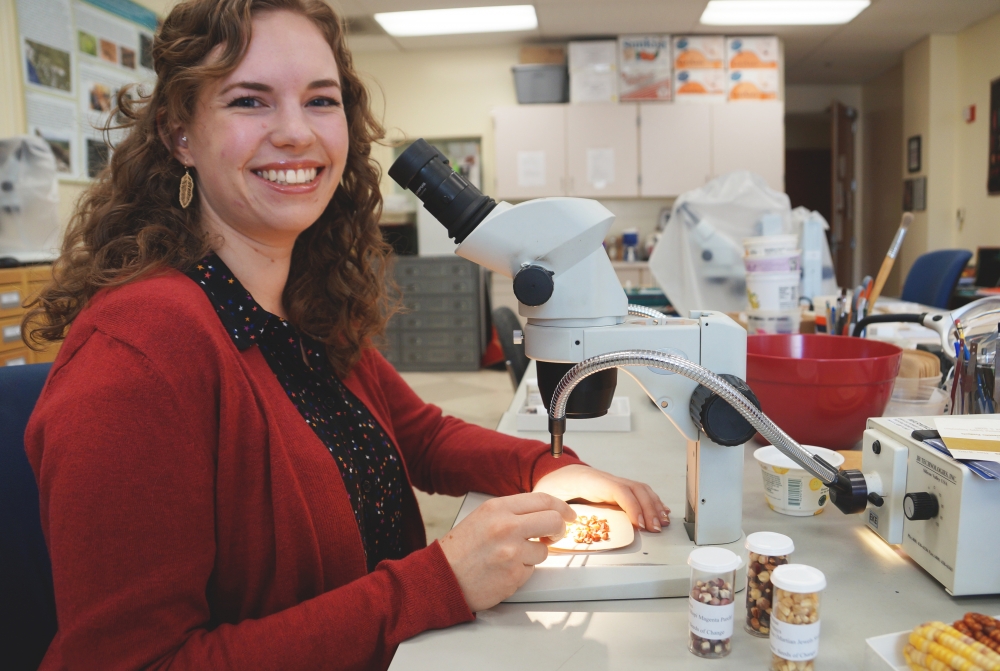Cooking and Culture
How did people interact with plants in the past? And how did they use food as an expression of their identities? Such questions are the central research focus of paleoethnobotanist Emily Johnson.
“I am particularly interested in understanding the ways that this identity and the role of food production was negotiated as societies become increasingly hierarchical, and politically and economically complex,” said Johnson, a doctoral student in anthropology at UC Santa Barbara. “The increased reliance on a few staple crops, such as maize, that often occur with this shift can be detrimental unless adaptations are made to the diet.”
Those adaptations include nixtamalization, a production process for maize known to play a significant role — for thousands of years — in the foodways of indigenous communities throughout North America, yet never explicitly affirmed in the archaeological record. Until now.
Johnson, based in the Integrative Subsistence Laboratory of her advisor, Professor Amber VanDerwarker, has developed the first direct method to identify nixtamalization in the past. Her research is published in the top-ranked Journal of Archaeological Science.
“Prior to this paper, it was not possible to directly identify the process of nixtamalization in the archaeological record — it could only be hypothesized to occur at sites with proxy evidence such as grinding stones and ceramic griddles,” Johnson said. “However, these items can also be used for a variety of other processing activities distinct from nixtamalization. Now, archaeologists can better understand the inception and spread of this significant cooking practice throughout time and space.”
The research is significant, noted VanDerwarker, because “it allows a path forward for archaeologists to identify when maize-growing groups throughout North and Central America adopted the technology of nixtamalization. We know that native groups adopted this technology before European contact, but until now it has been impossible to identify directly when this transition occurred archaeologically.”
The process in which maize is cooked in an alkaline solution, VanDerwarker explained, dramatically improves the nutritional content of maize, which is deficient in various amino acids, vitamins and minerals. In so doing, it helps to prevent severe malnutrition in populations dependent on maize as a staple food source.
“Emily’s work has been able to demonstrate that maize starch grain morphology changes during this process, and the starches from before versus after nixtamalization are highly diagnostic,” she said. “Now that this new method has been established, archaeologists throughout the Americas will try and determine the timing of this transition in their respective regions; this will be a highly cited and impactful publication.”
For her research, Johnson replicated the nixtamalization of maize in an effort to understand whether the damage from cooking impacted the starch granules — the primary component of maize — in significant and identifiable ways. By identifying these changes, nixtamalization could then be directly identified in the archaeological record by recovering the damaged starch granules from objects such as cooking and serving vessels and ground stone used to process the maize.
“While some studies have looked at how processes such as grinding, roasting and boiling have affected starch granules, no one has previously looked at how nixtamalization affects starch granules,” Johnson said. “Unique to this region, nixtamalization has become a way to not only boost the nutritional profile of maize, but a cultural element in its own right. The first step in the process of turning maize into masa for tortillas, tamales and more, it is clear that this cooking technique is still relevant to the health and cultures of people today.”
The next step in continuing this line of research, Johnson said, is to identify these modified starch granules in the archaeological record. She and VanDerwarker already have identified sites in the Southern Gulf lowlands in Mexico with long occupation histories and existing evidence of maize-dominated diets that “would be ideal for investigating when, where and how this process began.”
Co-authored with her undergraduate advisor, John Marston of Boston University, Johnson’s paper is the outcome of her senior thesis research at BU, where she won the Michael A. Sassano III and Christopher M. Sassano Award for Writing Excellence in the Social Sciences.





